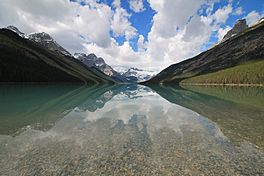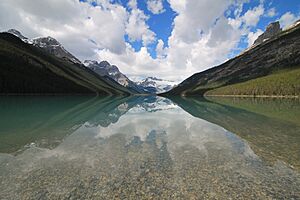Glacier Lake (Alberta) facts for kids
Quick facts for kids Glacier Lake |
|
|---|---|
 |
|
| Location | Alberta, Canada |
| Coordinates | 51°55′14″N 116°51′32″W / 51.92056°N 116.85889°W |
| Type | Glacial lake |
| Primary inflows | Glacier River |
| Primary outflows | Glacier River |
| Basin countries | Canada |
| Managing agency | Parks Canada |
| Max. length | 3.85 km (2.39 mi) |
| Max. width | 0.75 km (0.47 mi) |
| Surface elevation | 1,480 metres (4,860 ft) |
Glacier Lake is a beautiful and important lake in Banff National Park, Alberta, Canada. It is the fourth largest lake in this famous national park.
Contents
Glacier Lake: A Natural Wonder
Glacier Lake is known for its stunning natural beauty. It is surrounded by tall mountains like Mount Outram, Division Mountain, and Mount Erasmus. The lake gets its water from the Glacier River, which also flows out of the lake. This river eventually joins the Howse River.
How Glacier Lake Got Its Name
The lake was named by Sir James Hector in 1858. He was part of an exploration team called the Palliser expedition. He named it "Glacier Lake" because it is fed by water from glaciers. These glaciers include the Lyell and Mons Icefields, as well as the Forbes North Glacier.
Visiting Glacier Lake
If you want to visit Glacier Lake, you can hike there! There is a trail that is about 8.9 kilometers (5.5 miles) long. The trail starts near Saskatchewan River Crossing. This area is along the famous Icefields Parkway.
To find the start of the trail, look for the Glacier Lake trailhead. It is at the end of a short, unnamed road. This road is about 1.1 kilometers (0.7 miles) west of the turn-off for the David Thompson Highway.
Weather Around the Lake
The climate around Glacier Lake is called a subarctic climate. This means it has very cold and snowy winters. The summers are usually mild.
In winter, temperatures can drop below -20 degrees Celsius (-4 degrees Fahrenheit). With the wind chill, it can feel even colder, sometimes below -30 degrees Celsius (-22 degrees Fahrenheit).



